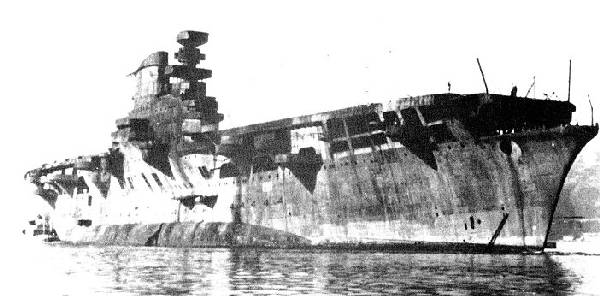




| Displacement | 24,000 tons |
| Armament | 8 x 1 135mm Plus smaller AA |
| Aircraft | 51 non-folding A/C |
| Speed | 30 knots |
| VTS Rating | 0 3 6 2 defense/1 offense |
The real Aquila , that was to be Italy's first aircraft carrier, was never completed. In 1940 the Italian High command realized that their otherwise fine navy was compromised by not having an air component travel with the fleet. Though air-minded Italy was thought to be an "unsinkable aircraft carrier", co-ordination between land-based air defense, land-based air reconnaisance, and the Fleet was poor at best, and in some ways the "cause" of several of the Regia Marina's defeats. Since luxury-liner travel had dropped off remarkedly once the war started, a transatlantic liner (Roma) was taken in hand in late 1941 to began conversion to an aircraft carrier. Since the name "Roma" was to be used for a new battleship coming out, the name for this new carrier was to be "Aquila" (Eagle). Fighters or fighter-bombers would make up her entire complement, as she was to be used mainly for fleet defense. A masterful and more thorough conversion than even the Japanese Junyo's, Aquila would have made a fine aircraft carrier. She sat, nearly complete, in Genoa harbor when Italy switched allegiances, and her crew sabotaged the ship so the Germans couldn't use her. She was scrapped post-war.
In "Grand Fleet" the Italians had been working with her training carrier Falco and the Fleet carrier Sagittario long enough to appreciate the significance of aircraft accompanying the Fleet, and was eagerly planning to convert ocean liners in the event of war. The task of a proper conversion was more than expected, but in the summer of 1940, with typical Italian relish the work proceeded. Though slowed by the material and manpower demands of the war, the Aquila was ready for trials in mid-1942 and with the Littorio-class battleship Roma proudly joined the Regia Marina in January of 1943.
The addition of the two ships breathed new life into the Regia Marina, but the war was turning against them too quickly. North Africa was now a battleground from both ends toward the middle (where Italy was) and supplies to the fighting fronts became more problematic and more essential. Guarding a convoy of Afrika Korps reinforcements, Aquila's Reggianne 2001 fighter-bombers and Re-2005 fighters fought back most of the RAF's attacks, but a skirmish with the Royal Navy's Mediterranean battlefleet sent the Regia Marina fleeing homeward. In port, Aquila was ordered to hoist the new Macchi-Castoldi 605 "Vendetta" torpedo bombers aboard for a "Doolittle"-type raid against the naval base at Alexandria. Tri-motored and tri-tailed, the folding-wing "Vendetta"s might have made a telling raid had not the Armistice intervened. Travelling southward with the surrendering Fleet, Aquila's fighters weren't numerous enough to prevent the Impero Romano's sinking by German aircraft. Intact and battle-tested, the now-"Allied" Aquila was relished as an addition to the British Far Eastern Fleet being assembled for the assault and re-conquest of Java. Along with the Molucca, Aquila formed the Air Support Group for the invasion. When the Group was surprised by a Japanese surface force, Aquila's "Vendetta"s hastily switched to torpedoes and attacked a battleship, scoring one hit, but the overwhelming firepower of the Japanese plastered the Aquila and started fires that eventually gutted the ship and forced abandonment. Considered by the Allies as not worth saving, the Aquila was used as a submarine target vessel and sent to the bottom by the USS Tadpole.


